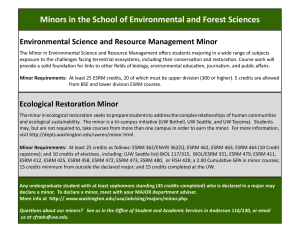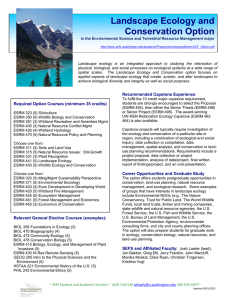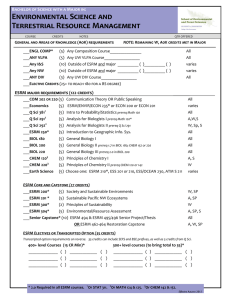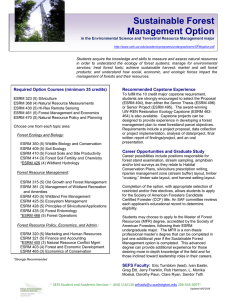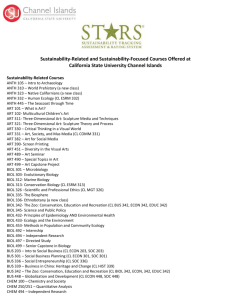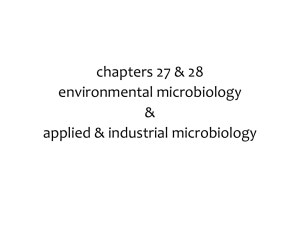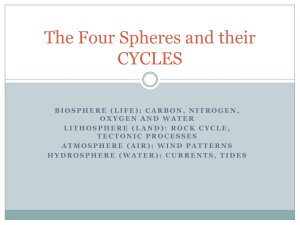Biogeochemical Cycles - University of Washington
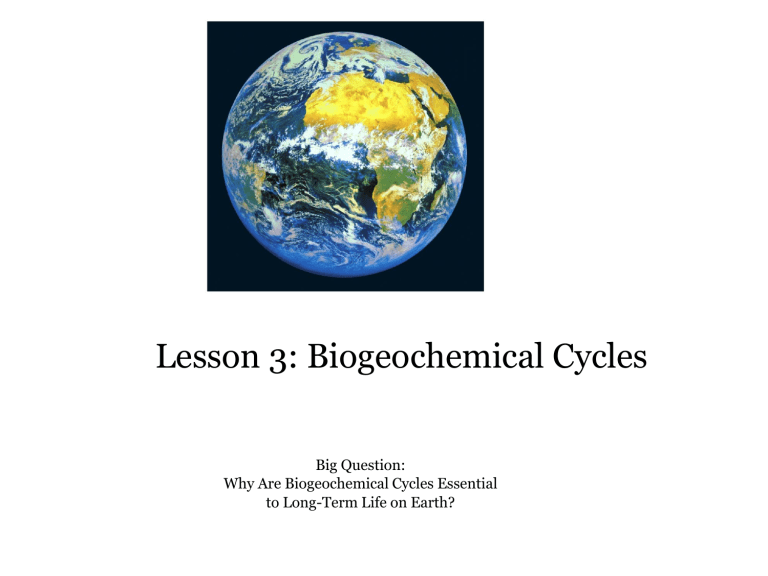
Lesson 3: Biogeochemical Cycles
Big Question:
Why Are Biogeochemical Cycles Essential to Long-Term Life on Earth?
What is a Biogeochemical Cycle?
• A biogeochemical cycle is the complete path a chemical takes through the Earth’s four major reservoirs:
• atmosphere
• hydrosphere (oceans, rivers, lakes, groundwaters, and glaciers)
• lithosphere (rocks and soils)
• biosphere (plants and animals).
Lesson 3/ ESRM 100 / University of Washington
Chemical Sinks
• Chemicals enter storage compartments - sinks
• Amount that moves between compartments is the flux
• net sink - when input exceeds output
• net source - if output exceeds input.
Lesson 3/ ESRM 100 / University of Washington
New Carbon versus Fossil Carbon
Lesson 3/ ESRM 100 / University of Washington
Essential Elements
24 elements are required for life
Macronutrients are required in large quantities
• carbon, hydrogen, nitrogen, oxygen, phosphorus, and sulfur.
Micronutrients are required in small/medium quantities, or not at all in some organisms
• copper, sodium, iodine
• See dhmo.org
for a discussion of the deadly chemical dihydrogen monoxide.
Lesson 3/ ESRM 100 / University of Washington
Essential Elements
Lesson 3/ ESRM 100 / University of Washington
Geological Cycle
The formation and change of Earth materials through physical, chemical, and biological processes.
Here is a great move about the Geological Cycle: http://www.britannica.com/EBchecked/topic/229677/geologiccycle
Lesson 3/ ESRM 100 / University of Washington
Tectonic Cycle
The lithosphere is comprised of several plates floating on denser material.
Plates move slowly relative to each other – plate tectonics,
Divergent plate boundaries occur at spreading ocean ridges.
Convergent plate boundaries occur when plates collide.
Plate movements change the location of continents and alter atmospheric and ocean circulation patterns.
Plate boundaries are geologically active, producing volcanoes and earthquakes.
Lesson 3/ ESRM 100 / University of Washington
Major Tectonic Plates
Lesson 3/ ESRM 100 / University of Washington
Hydrologic Cycle
Evaporation
Precipitation
Runoff
Groundwater
Lesson 3/ ESRM 100 / University of Washington
Where Is the Earth's Water?
97% of water is stored in oceans, 2% in glaciers and ice caps, 1% as freshwater on land or atmosphere.
Drainage basins or watersheds are the area contributing runoff to a stream or river.
Vary in size from a hectare to millions of square miles (e.g.
Mississippi River drainage basin).
Human impacts include dam construction, irrigation, stormwater runoff.
Lesson 3/ ESRM 100 / University of Washington
Rock Cycle
Lesson 3/ ESRM 100 / University of Washington
Rock Cycle
Lesson 3/ ESRM 100 / University of Washington
Biogeochemical Cycle of Ca in a Forest
Soluble in water and easily lost through runoff
Lesson 3/ ESRM 100 / University of Washington
Sulfur Cycle In a Forest Ecosystem
Includes gaseous forms (sulfur dioxide and hydrogen sulfide) and cycles much faster than calcium
Lesson 3/ ESRM 100 / University of Washington
Nitrogen Cycle In a Forest Ecosystem
Lesson 3/ ESRM 100 / University of Washington
Carbon Cycle
Carbon is vital for life but is not abundant
Enters biological cycles through photosynthesis to produce organic forms of carbon
Lesson 3/ ESRM 100 / University of Washington
Carbon Cycle in a Lake
Rob's daughter Joanna (on right) removes C in trout.
Lesson 3/ ESRM 100 / University of Washington
Fossil Fuels
•
Fossil Fuels are created by the accumulation of carbon from dead organisms in rock strata. Their decomposition is prevented by lack of oxygen or low temperatures after their burial in sediments. After thousands or millions of years of burial the stored organic carbon is transferred into coal, oil or natural gas.
Lesson 3/ ESRM 100 / University of Washington
Global Carbon Cycle
Lesson 3/ ESRM 100 / University of Washington
Missing Carbon Sink
Several hundred million tons of carbon released from the burning of fossil fuels cannot be accounted for.
Possible sinks include terrestrial forests, soils, and ocean ecosystems.
Lesson 3/ ESRM 100 / University of Washington
Nitrogen Cycle
Essential for manufacturing proteins and DNA
Although 80% of atmosphere is molecular nitrogen, it is unreactive and cannot be used directly
Nitrogen fixation converts nitrogen to ammonia or nitrate
Lesson 3/ ESRM 100 / University of Washington
Global Nitrogen Cycle
Lesson 3/ ESRM 100 / University of Washington
Phosphorus Cycle
No gaseous phase
Slow rate of transfer
Released by erosion of exposed rock
Absorbed by plants, algae, and some bacteria
Exported from terrestrial ecosystems by runoff to oceans
May be returned through seabird guano
Lesson 3/ ESRM 100 / University of Washington
Global Phosphorus Cycle
Lesson 3/ ESRM 100 / University of Washington
Chapter 3: Biogeochemical Cycles
Questions? E-mail your TA.
